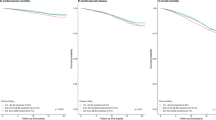Abstract
Background: A single measurement of glycated hemoglobin (HbA1c) is a weak predictor for cardiovascular events in patients without Type 2 diabetes mellitus. We hypothesized that dynamic changes in HbA1c (Delta-HbA1c) would better predict cardiovascular outcome than a single value. Methods: In 99 consecutive patients with stable coronary artery disease (CAD) and without diabetes mellitus who were seen twice in our outpatient clinic (4–6 months apart) in 1998, Delta-HbA1c (follow-up HbA1c–baseline HbA1c) was assessed. Between August and September 2007 (mean observation period 9.1 yr), patients and their physicians were contacted by telephone to evaluate the incidence of cardiovascular endpoints. The combined primary endpoint of our study was defined as the incidence of myocardial infarction, stroke or death from any cause. The endpoints were validated by chart review. Results: Multivariate analysis demonstrated that the change of HbA1c between first and second examination in 1998 was the most powerful parameter for prediction of the combined primary endpoint in the next 9 yr. The hazard ratio was 5.03 [95% confidence interval (CI) 1.4–17.9] for any increase in HbA1c and 1.99 (95%CI 1.3–3.0) for an HbA1c increase of 0.3%. In addition, Kaplan-Meier survival analysis showed a significant association between endpoint-free survival and dynamic changes in HbA1c. Conclusions: Hence, changes in the glucometabolic milieu within 4–6 months calculated by the difference of two values of HbA1c affect the long-term prognosis of patients with CAD but without diabetes mellitus.
Similar content being viewed by others
References
Tahara Y, Shima K. Kinetics of HbA1c, glycated albumin, and fructosamine and analysis of their weight functions against preceeding plasma glucose level. Diabetes Care 1995, 18: 440–7.
Khaw KT, Wareham N, Bingham S, Luben R, Welch A, Day N. Association of hemoglobin A1c with cardiovascular disease and mortality in adults: the European prospective investigation into cancer in Norfolk Ann Intern Med 2004, 141: 413–20.
Pradhan AD, Rifai N, Buring JE, Ridker PM. Hemoglobin A1c predicts diabetes but not cardiovascular disease in nondiabetic women. Am J Med 2007, 120: 720–7.
Selvin E, Coresh J, Golden SH, Brancati FL, Folsom AR, Steffes MW. Glycemic control and coronary heart disease risk in persons with and without diabetes: the atherosclerosis risk in communities study. Arch Intern Med 2005, 165: 1910–6.
O’Sullivan CJ, Hynes N, Mahendran B, et al. Haemoglobin A1c (HbA1c) in non-diabetic and diabetic vascular patients. Is HbA1c an independent risk factor and predictor of adverse outcome? Eur J Vasc Endovasc Surg 2006, 32: 188–97.
Jørgensen L, Jenssen T, Joakimsen O, Heuch I, Ingebretsen OC, Jacobsen BK. Glycated hemoglobin level is strongly related to the prevalence of carotid artery plaques with high echogenicity in nondiabetic individuals: the Tromsø study. Circulation 2004, 110: 466–70.
Schneider CA, Diedrichs H, Riedel KD, Zimmermann T, Höpp HW. In vivo uptake of azithromycin in human coronary plaques. Am J Cardiol 2000, 86: 789–91.
Blake GJ, Pradhan AD, Manson JE, et al. Hemoglobin A1c level and future cardiovascular events among women. Arch Intern Med 2004, 164: 757–61.
de Vegt F, Dekker JM, Ruhé HG, et al. Hyperglycaemia is associated with all-cause and cardiovascular mortality in the Hoorn population: the Hoorn Study. Diabetologia 1999, 42: 926–31
Monnier L, Lapinski H, Colette C. Contributions of fasting and postprandial plasma glucose increments to the overall diurnal hyperglycemia of type 2 diabetic patients: variations with increasing levels of HbA(1c). Diabetes Care 2003, 26: 881–5.
Rohlfing CL, Wiedmeyer HM, Little RR England JD, Tennill A, Goldstein DE. Defining the relationship between plasma glucose and HbA(1c): analysis of glucose profiles and HbA(1c) in the Diabetes Control and Complications Trial. Diabetes Care 2002, 25: 275–8.
Ceriello A. The post-prandial state and cardiovascular disease: relevance to diabetes mellitus. Diabetes Metab Res Rev 2000, 16: 125–32.
Temelkova-Kurktschiev T, Koehler C, Schaper F, et al. Relationship between fasting plasma glucose, atherosclerosis risk factors and carotid intima media thickness in non-diabetic individuals. Diabetologia 1998, 41: 706–12.
Author information
Authors and Affiliations
Corresponding author
Additional information
Both authors contributed equally to this work.
Rights and permissions
About this article
Cite this article
Diedrichs, H., Pfister, R., Clement, Z. et al. Delta-glycated hemoglobin: A novel independent risk factor for cardiovascular events in patients without diabetes mellitus. J Endocrinol Invest 32, 564–567 (2009). https://doi.org/10.1007/BF03346509
Accepted:
Published:
Issue Date:
DOI: https://doi.org/10.1007/BF03346509




